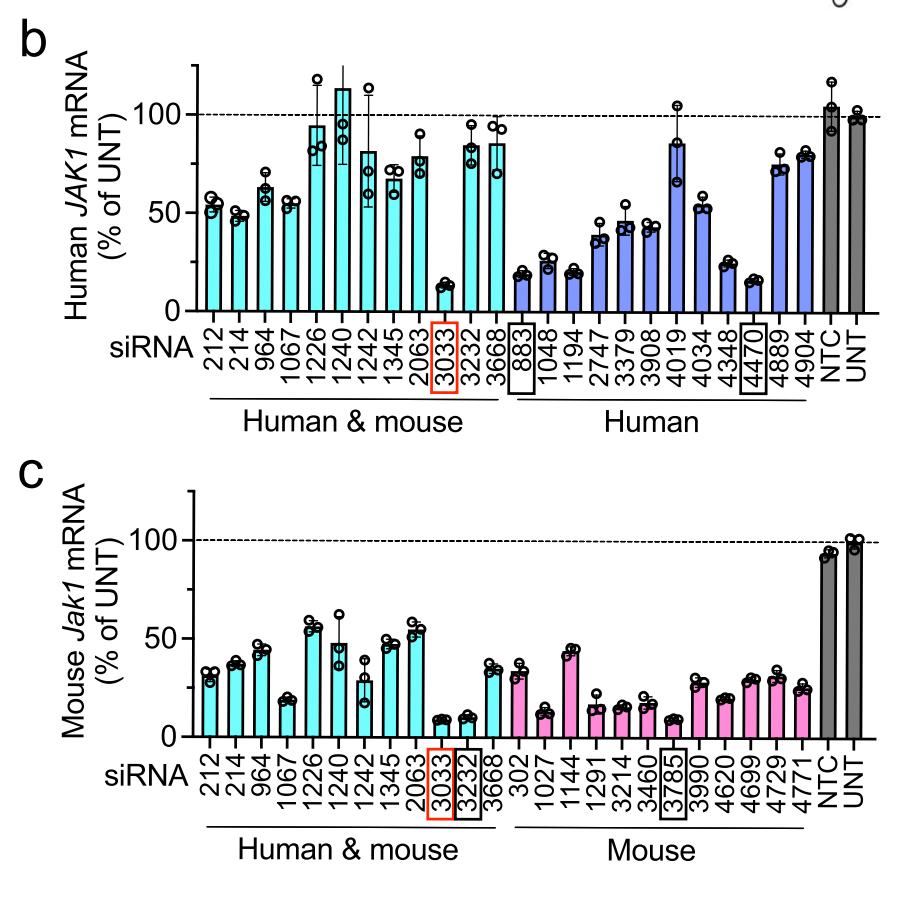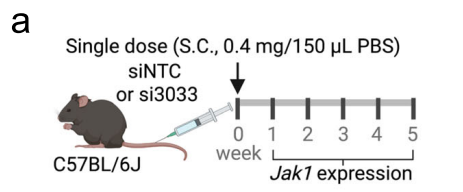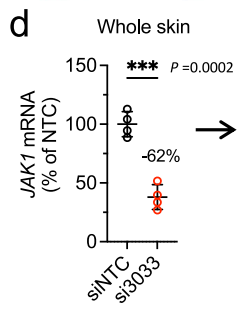Editor: Nina
This study presents the development and efficacy of a JAK1-selective small interfering RNA (siRNA), which effectively silences JAK1 to modulate autoimmune responses and prevent depigmentation in vitiligo, offering a promising therapeutic alternative to traditional JAK inhibitors.
Key Preview
Research Question
The study investigates the potential of a selectively designed small interfering RNA (siRNA) to inhibit Janus kinase 1 (JAK1) in order to modulate autoimmune responses in dermatological conditions, particularly vitiligo.
Research Design and Strategy
The research employed a systematic approach to design and test a JAK1-selective siRNA, demonstrating its efficacy in preclinical models, including human skin explants and a mouse model of vitiligo.
Method
The team synthesized a panel of chemically modified siRNA sequences targeting JAK1, evaluating their silencing efficacy in various cell lines and tissue models.
Key Results
The lead siRNA, named 3033, effectively silenced JAK1 in human and mouse models, leading to reduced skin infiltration of autoreactive CD8+ T cells and prevention of depigmentation in a mouse model of vitiligo.
Significance of the Research
This work establishes a novel therapeutic approach using RNA interference for treating inflammatory and autoimmune skin diseases, potentially offering a safer alternative to existing JAK inhibitors.
Introduction
Research into JAK inhibitors has surged in recent years, particularly for treating autoimmune diseases. JAKs, crucial for transducing signals from various cytokines, have been implicated in the pathogenesis of skin conditions such as vitiligo. Traditional small molecule JAK inhibitors, while effective, often affect multiple JAK subtypes, leading to side effects. The current study presents an innovative solution: a rationally designed siRNA that selectively silences JAK1, thereby narrowing the therapeutic spectrum and minimizing adverse effects. The primary research question seeks to ascertain whether this selective inhibition can effectively modulate autoimmune responses in the skin.
Research Team and Objective
The research was conducted by an interdisciplinary team from the University of Massachusetts Chan Medical School, led by Qi Tang and co-authored by Hassan H. Fakih, Mohammad Zain UI Abideen, and others. The paper titled “Rational design of a JAK1-selective siRNA inhibitor for the modulation of autoimmunity in the skin” was published in Nature Communications. The objective was to explore the therapeutic potential of a JAK1-selective siRNA in treating autoimmune skin conditions, particularly focusing on its efficacy in preventing the pathological processes associated with vitiligo.
Experimental Process
1. siRNA Design
- Key Steps: The researchers utilized a proprietary siRNA design algorithm to generate a diverse panel of 150 sequences targeting JAK1 across human, mouse, and non-human primate transcripts. These sequences were designed to target different regions of the JAK1 mRNA, including the 5’-untranslated region (UTR), open reading frame, and 3’-UTR, ensuring optimal specificity and efficacy.
- Results and Key Data: The top candidates, particularly those in the human and mouse categories, were synthesized and subsequently screened in vitro.

Figure 1. b, c In vitro screening of siRNAs in human HeLa (b) and mouse N2a © cells.
- Significance of the Result: This systematic approach allowed for the identification of siRNA sequences with high specificity for JAK1, thereby minimizing off-target effects.
- Key Innovations: The use of cross-species targeting increased the potential applicability of the selected siRNAs across different animal models, enhancing translational research opportunities.
2. In Vitro Screening
- Key Steps: The synthesized siRNAs were transfected into human HeLa and mouse N2a cells at a concentration of 1.5 μM. The cells were then incubated for 72 hours to allow for effective gene silencing. Post-incubation, mRNA levels of JAK1 were measured using the QuantiGene 2.0 assay.
- Results and Key Data: The lead compound, siRNA 3033, demonstrated a remarkable 90% reduction in JAK1 mRNA levels in both human and mouse cells, outpacing several other candidates identified in the primary screening.
- Significance of the Result: The substantial silencing efficacy confirmed the potential of siRNA 3033 as a selective JAK1 inhibitor, which is crucial for therapeutic applications in autoimmune skin diseases.
- Key Innovations: The incorporation of cholesterol-conjugation allowed for enhanced cellular uptake, leveraging passive diffusion mechanisms to improve delivery efficiency compared to traditional delivery methods.
3. In Vivo Testing
- Key Steps: si3033 was injected subcutaneously into C57Bl/6J mice at a dose of 0.4 mg in 150 µL of PBS. JAK1 mRNA expression in the skin was monitored over five weeks post-injection.
- Results and Key Data: The results showed sustained silencing of JAK1 mRNA, with approximately 40-50% silencing observed at week one, which maintained significant downregulation for five weeks.

Figure 2. a Single-dose subcutaneous (S.C.) injection of si3033 at 20 mg/kg supports Jak1 silencing in tail skin for over 5 weeks (n = 5 animals, mean ± s.d.; two-sided unpaired t test, *P < 0.05, **P < 0.01, ***P < 0.001); QuantiGene 2.0 assay and presented as percentage of siNTC control.
- Significance of the Result: This prolonged duration of effect indicates that a single injection could provide long-term therapeutic benefits, reducing the need for frequent dosing.
- Key Innovations: The hydrophobic conjugation to docosanoic acid (DCA) facilitated local retention of siRNA at the injection site, significantly minimizing systemic exposure and potential side effects compared to traditional nano-delivery systems, which often lead to rapid systemic distribution and associated complications.
4. Efficacy in Vitiligo Model
- Key Steps: To assess therapeutic efficacy, si3033 was administered in a mouse model of vitiligo induced by the adoptive transfer of autoreactive CD8+ T cells. The mice received two doses of si3033 prior to disease induction.
- Results and Key Data: Mice treated with si3033 exhibited significantly reduced skin infiltration of autoreactive CD8+ T cells and prevented epidermal depigmentation compared to controls receiving nontargeting siRNA (siNTC). Statistical analysis confirmed a significant reduction in skin depigmentation severity.
- Significance of the Result: The ability of si3033 to modulate the immune response and prevent depigmentation underscores its potential as a novel therapeutic option for treating vitiligo and potentially other autoimmune skin disorders.
- Key Innovations: si3033’s selective action on JAK1, without affecting other JAK family members, offers a targeted approach to immunomodulation, potentially leading to fewer side effects than traditional broad-spectrum JAK inhibitors.
5. Human Skin Explants
- Key Steps: si3033 was injected into human skin explants, and its distribution and efficacy were evaluated after 24 hours. The explants were cultured under standard conditions, and JAK1 mRNA levels were measured post-treatment.
- Results and Key Data: si3033 resulted in approximately 62% silencing of JAK1 mRNA in human skin, with significant downregulation of IFN-γ-inducible chemokines (CXCL9, CXCL10, CXCL11) observed after stimulation with recombinant IFN-γ.

Figure 3. JAK1 silencing in whole skin
- Significance of the Result: The effective silencing of JAK1 in human skin confirms the translational potential of si3033 for treating autoimmune skin diseases in humans.
- Key Innovations: The ex vivo application of si3033 in human skin highlights the advantages of localized delivery systems that capitalize on the natural architecture of skin, providing a more effective route of administration compared to systemic approaches typically used in traditional therapies.
Conclusion
This pioneering study reveals that the rational design of a JAK1-selective siRNA offers a promising new avenue for treating autoimmune skin diseases like vitiligo. The findings indicate that selective JAK inhibition can reduce autoreactive T-cell infiltration and inflammatory responses in the skin, with the potential for fewer side effects compared to current therapies. However, the research is not without limitations; further studies are necessary to assess the long-term safety and efficacy of siRNA treatments in diverse populations. Future research should also aim to explore the adaptability of this approach across different inflammatory conditions and species, thereby broadening the therapeutic scope of this innovative modality.
Reference:
Tang, Qi, et al. “Rational design of a JAK1-selective siRNA inhibitor for the modulation of autoimmunity in the skin.” Nature Communications 14.1 (2023): 7099.
